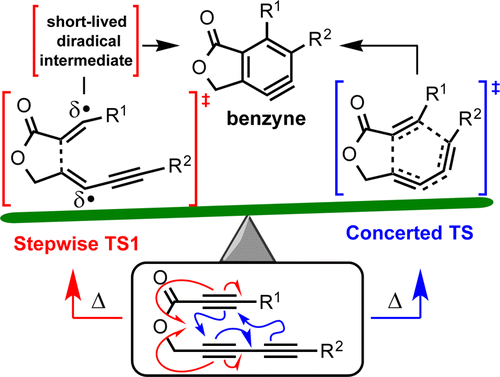Marell, D. J.; Furan, L. R.; Woods, B. P.; Lei, X.; Bendelsmith, A. J.; Cramer, C. J.; Hoye, T. R.; Kuwata, K. T. J. Org. Chem. 2015, 80, 11744–11754.
Invited contribution to special issue: 50 Years and Counting: The Woodward-Hoffmann Rules in the 21st Century
Theoretical analysis of the mechanism of the intramolecular hexadehydro-Diels–Alder (HDDA) reaction, validated against prior and newly measured kinetic data for a number of different tethered yne-diynes, indicates that the reaction proceeds in a highly asynchronous fashion. The rate-determining step is bond formation at the alkyne termini nearest the tether, which involves a transition-state structure exhibiting substantial diradical character. Whether the reaction then continues to close the remaining bond in a concerted fashion or in a stepwise fashion (i.e., with an intervening intermediate) depends on the substituents at the remaining terminal alkyne positions. Computational modeling of the HDDA reaction is complicated by the significant diradical character that arises along the reaction coordinate, which leads to instabilities in both restricted singlet Kohn–Sham density functional theory (DFT) and coupled cluster theory based on a Hartree–Fock reference wave function. A consistent picture emerges, however, from comparison of broken-symmetry DFT calculations and second-order perturbation theory based on complete-active-space self-consistent-field (CASPT2) calculations.
